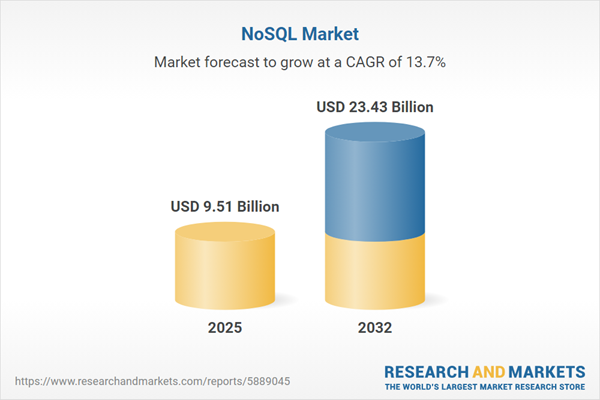Speak directly to the analyst to clarify any post sales queries you may have.
The NoSQL market is rapidly shaping enterprise approaches to data management, driving secure, agile, and scalable operations that align with evolving business priorities. As organizations accelerate digital transformation, investing in advanced data infrastructure remains a strategic focus for senior leaders seeking lasting competitive advantage.
NoSQL Market Snapshot: Size and Growth
The global NoSQL market is projected to increase from USD 8.36 billion in 2024 to USD 9.51 billion in 2025, with long-term expectations of reaching USD 23.43 billion by 2032. This represents a compound annual growth rate of 13.73%. Enterprises are decisively adopting modern data infrastructure, shifting investment towards solutions that support varied data types and scaling analytics across the organization. CIOs rely on NoSQL platforms for robust digital initiatives, seamless business intelligence integration, and simplifying management of complex data landscapes, all aimed at maintaining responsiveness as business, regulatory, and operational landscapes evolve.
NoSQL Market Scope & Segmentation
- Database Type: Column Family, Document, Graph, and Key Value databases each address unique and complex business needs, enabling flexible modeling of relationships and supporting use cases across industries such as retail, finance, and healthcare.
- Deployment Model: Cloud-based platforms, including public, private, and hybrid environments, are prioritized for their scalability and rapid provisioning. On-premises deployment continues to serve organizations that demand enhanced compliance, governance, and direct control over data infrastructure.
- Organization Size: Both small businesses and large enterprises recognize the value of scalable systems, adopting NoSQL to optimize workflows, reduce bottlenecks, and strengthen digital capabilities amid shifting operational pressures.
- Application: NoSQL technologies underpin vital functions such as digital content management, enabling rapid scaling for IoT solutions, powering real-time data analytics, and supporting social engagement platforms—all critical functions for operational resilience and positive user experiences.
- End User Vertical: Financial services, healthcare providers, telecommunications, insurance, retail, IT, and media firms integrate NoSQL to satisfy compliance mandates, elevate customer interactions, manage growing datasets, and derive business insights from dynamic sources.
- Regions: Adoption is robust across the Americas, EMEA, and Asia-Pacific regions. Countries including the United States, Germany, China, India, and the United Kingdom lead the market, with local regulatory frameworks and modernization pushes guiding deployment priorities.
- Key Companies: MongoDB, Inc., Amazon Web Services, Microsoft Corporation, Redis Ltd, DataStax, Couchbase, IBM, Neo4j, MarkLogic, and Aerospike form the competitive landscape, providing reliable platforms that cater to enterprise-grade data infrastructure needs.
NoSQL Market: Key Takeaways for Senior Decision-Makers
- NoSQL solutions enable enterprises to adapt quickly to changes in regulations and operational structures, supporting sustained business continuity and iterative development.
- Supporting adoption of microservices and embedding analytics within daily workflows increases organizational agility, improves operational cohesion, and streamlines transformation at scale.
- Integrating NoSQL with artificial intelligence and edge computing empowers organizations with advanced insights, enabling prompt, data-driven strategy execution and improved responsiveness.
- Hybrid and multi-cloud strategies offer stronger infrastructure resilience and unified compliance management, particularly for organizations operating across multiple jurisdictions.
- Leveraging managed services and open-source frameworks grants flexibility in technology procurement, optimizes expenditure, and reduces reliance on proprietary hardware vendors.
- Equipping development teams with secure, real-time data access supports proactive technology adoption and positions enterprises to address emerging requirements while safeguarding ongoing competitiveness.
NoSQL Market: Tariff Impact on Infrastructure and Procurement
Recent changes in U.S. tariffs have raised costs associated with networking and physical infrastructure, particularly affecting those with on-premises deployments. Enterprises are mitigating risks by updating supply chain strategies and intensifying cloud migration efforts. Vendors have responded by increasing local data center investments and offering more managed services. In this dynamic, open-source NoSQL solutions are becoming increasingly attractive for procurement due to their flexibility and alignment with risk reduction strategies during fluid market conditions.
Methodology & Data Sources
This overview is grounded in primary interviews with C-level IT leaders, database architects, and engineering leads, complemented by ongoing updates from major vendors and thorough secondary research. Consideration of regulatory dynamics clarifies adoption trends and highlights sector-specific challenges in the evolving digital infrastructure space.
Why This Report Matters
- Granular segmentation and competitive insights empower leaders to optimize strategic planning and procurement approaches.
- Coverage of technological advancements and evolving compliance drivers supports the design and sustainment of future-proof data systems.
- Actionable analysis provides context to help decision-makers manage risk and retain agility while facing shifting business and regulatory demands.
Conclusion
NoSQL technologies are integral to modernizing enterprise infrastructure, securing data, and supporting scalable operations. For leaders, leveraging these platforms is key to building adaptive digital strategies and ensuring sustained organizational flexibility.
Additional Product Information:
- Purchase of this report includes 1 year online access with quarterly updates.
- This report can be updated on request. Please contact our Customer Experience team using the Ask a Question widget on our website.
Table of Contents
3. Executive Summary
4. Market Overview
7. Cumulative Impact of Artificial Intelligence 2025
Companies Mentioned
The companies profiled in this NoSQL market report include:- MongoDB, Inc.
- Amazon Web Services, Inc.
- Microsoft Corporation
- Redis Ltd
- DataStax, Inc.
- Couchbase, Inc.
- International Business Machines Corporation
- Neo4j, Inc.
- MarkLogic Corporation
- Aerospike, Inc.
Table Information
| Report Attribute | Details |
|---|---|
| No. of Pages | 193 |
| Published | October 2025 |
| Forecast Period | 2025 - 2032 |
| Estimated Market Value ( USD | $ 9.51 Billion |
| Forecasted Market Value ( USD | $ 23.43 Billion |
| Compound Annual Growth Rate | 13.7% |
| Regions Covered | Global |
| No. of Companies Mentioned | 11 |









